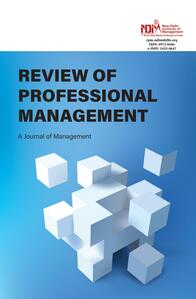
1Department of Commerce, Delhi School of Economics, University of Delhi, India
2 Faculty of Management Studies, University of Delhi, India

Creative Commons Non Commercial CC BY-NC: This article is distributed under the terms of the Creative Commons Attribution-NonCommercial 4.0 License (http://www.creativecommons.org/licenses/by-nc/4.0/) which permits non-Commercial use, reproduction and distribution of the work without further permission provided the original work is attributed.
Small and medium enterprises (SMEs) are crucial for economic development, contributing significantly to employment, innovation, and overall economic stability. However, SMEs face challenges such as asymmetric information and ex-ante uncertainty due to their relatively short operational histories, and also, SME exchanges have relatively fewer regulations and listing requirements as compared to mainboard exchanges. By leveraging various signals, such as the reputation of underwriters, these issues can be mitigated during the IPO process. This study aims to explore the signalling role of prominent underwriters and their effects on initial returns and post-issue stock performance of IPOs in India. This study includes the data of 298 IPOs of SME firms listed on the BSE SME platform and NSE EMERGE between April 2012 and March 2020, which were collected from CMIE Prowess. The signalling function of underwriters was tested using multiple regression analysis. The result shows that Underwriter reputation (UWR) positively affects underpricing, but in the long term, it does not have any impact on post-issue stock performance of an IPO Firm.
Underwriter reputation, IPO returns, underpricing, BHAR, Information asymmetry
Allen, F., & Faulhaber, G. R. (1989). Signalling by underpricing in the IPO market. Journal of Financial Economics, 23(2), 303–323. https://doi.org/10.1016/0304-405X(89)90060-3
Arora, N., & Singh, B. (2019). Determinants of IPO underpricing: Evidence from India. Global Business Review, 20(1), 187–213. https://doi.org/10.1177/0972150918811232
Beatty, R. P., & Ritter, J. R. (1986). Investment banking, reputation, and the underpricing of initial public offerings. Journal of Financial Economics, 15(1–2), 213–232. https://doi.org/10.1016/0304-405X(86)90055-3
Bhabra, H. S., & Pettway, R. H. (2003). IPO prospectus information and subsequent performance. Financial Review, 38(3), 369–397. https://doi.org/10.1111/1540-6288.00052
Boehmer, E., & Fishe, R. P. H. (2004). Do underwriters encourage stock liquidity? Evidence from IPOs. Journal of Banking & Finance, 28(4), 835–859. https://doi.org/10.1016/j.jbankfin.2003.11.003
Booth, J. R., & Chua, L. (1996). Ownership dispersion, costly information, and IPO underpricing. Journal of Financial Economics, 41(2), 291–310. https://doi.org/10.1016/0304-405X(95)00863-F
Campello, M. (2006). Debt financing: Does it boost or hurt firm performance? Evidence from a cross-industry comparison. Journal of Financial Economics, 82(1), 135–172. https://doi.org/10.1016/j.jfineco.2005.04.001
Carter, R. B., & Manaster, S. (1990). Initial public offerings and underwriter reputation. Journal of Finance, 45(4), 1045–1067. https://doi.org/10.1111/j.1540-6261.1990.tb02426.x
Chen, G., Firth, M., & Kim, J. B. (2004). IPO underpricing in China’s new stock markets. Journal of Multinational Financial Management, 14(3), 283–302. https://doi.org/10.1016/j.mulfin.2004.03.002
Dhamija, S., & Arora, R. K. (2017). Impact of quality certification on IPO underpricing: Evidence from India. Global Business Review, 19(1), 69–84. https://doi.org/10.1177/0972150917749282
Johnson, J. M., & Miller, R. E. (1988). Investment banker prestige and the underpricing of initial public offerings. Journal of Finance. https://doi.org/10.1111/j.1540-6261.1988.tb04593.x
Katti, S., & Phani, B. V. (2016). Underpricing of initial public offerings: A literature review. Universal Journal of Accounting and Finance, 4(2), 35–52. https://doi.org/10.13189/ujaf.2016.040202
Khanna, T., & Palepu, K. (2010). Winning in emerging markets: A road map for strategy and execution. Harvard Business Press.
Kim, M., & Ritter, J. R. (1999). Valuing IPOs. Journal of Financial Economics, 53(3), 409–437. https://doi.org/10.1016/S0304-405X(99)00027-6
Krigman, L., Shaw, W., & Womack, K. (1999). The persistence of IPO mispricing and the predictive power of flipping. Journal of Finance, 54(3), 1015–1044. https://doi.org/10.1111/0022-1082.00136
Ljungqvist, A. (2007). IPO underpricing. In Handbook of corporate finance: Empirical corporate finance (Vol. 1, pp. 375–422). Elsevier. https://doi.org/10.1016/B978-0-444-53265-7.50018-3
Ljungqvist, A., Nanda, V., & Singh, R. (2006). Hot markets, investor sentiment, and IPO pricing. Journal of Business, 79(4), 1667–1702. https://doi.org/10.1086/503644
Loughran, T., & Ritter, J. (2004). Why has IPO underpricing changed over time? Financial Management, 33(3), 5–37. https://doi.org/10.2139/ssrn.331780
Megginson, W. L., & Weiss, K. A. (1991). Venture capitalist certification in initial public offerings. Journal of Finance, 46(3), 879–903. https://doi.org/10.1111/j.1540-6261.1991.tb03770.x
Michaely, R., & Shaw, W. H. (1994). The pricing of initial public offerings: Tests of adverse-selection and signaling theories. Review of Financial Studies, 7(2), 279–319. https://doi.org/10.1093/rfs/7.2.279
Pagano, M., Panetta, F., & Zingales, L. (1998). Why do companies go public? An empirical analysis. Journal of Finance, 53(1), 27–64. https://doi.org/10.1111/0022-1082.25448
Pandey, N., & Vaidyanathan, R. (2013). Determinants of IPO underpricing in the national stock exchange of India. IIM Bangalore Research Paper, 396, 1–38. https://doi.org/10.2139/ssrn.2293411
Reutzel, C. R., & Belsito, C. A. (2015). Female directors and IPO underpricing in the US. International Journal of Gender and Entrepreneurship, 7(1), 27–44. https://doi.org/10.1108/IJGE-01-2013-0003
Ritter, J. R. (1984). The hot issue market of 1980. Journal of Business, 57(2), 215–240. https://doi.org/10.1086/296260
Ritter, J. R., & Welch, I. (2002). A review of IPO activity, pricing, and allocations. Journal of Finance, 57(4), 1795–1828. https://doi.org/10.1111/1540-6261.00478
Rock, K. (1986). Why new issues are underpriced. Journal of Financial Economics, 15(1–2), 187–212. https://doi.org/10.1016/0304-405X(86)90054-1
Sahoo, S., & Rajib, P. (2010). Aftermarket pricing performance of IPOs: Indian IPO market 2002–2006. Vikalpa, 35(4), 27–43. https://doi.org/10.1177/0256090920100404
SEBI. (2012). Guidelines for SME listing on BSE and NSE Emerge. Retrieved from https://www.sebi.gov.in
Sestanovic, M. (2015). Initial public offerings: Success factors for underwriters and investors. Journal of Finance and Investment Analysis, 4(3), 45–60. https://doi.org/10.2139/ssrn.2754266
SIDBI. (2013). MSME sector: Performance and potential. SIDBI report on MSME sector, 2013. https://msme.gov.in/sites/default/files/ANNUALREPORT-MSME-2012-13P.pdf
Spence, M. (1973). Job market signaling. Quarterly Journal of Economics, 87(3), 355–374. https://doi.org/10.2307/1882010
Sundarasen, S. D., Khan, A., & Rajangam, N. (2018). Signalling roles of prestigious auditors and underwriters in an emerging IPO market. Global Business Review, 19(1), 69–84. https://doi.org/10.1177/0972150917749283
Welch, I. (1989). Seasoned offerings, imitation costs, and the underpricing of IPOs. Journal of Finance, 44(2), 421–449. https://doi.org/10.1111/j.1540-6261.1989.tb05064.x
World Bank. (2020). SMEs finance: Improving SMEs’ access to finance and finding innovative solutions to unlock sources of capital. https://doi.org/10.1596/978-1-4648-1406-7
Zhang, Y. (2008). The financial leverage effect on long-term IPO performance. Journal of Corporate Finance, 14(1), 28–45. https://doi.org/10.1016/j.jcorpfin.2008.10.004